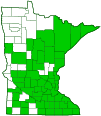garlic mustard
(Alliaria petiolata)
Conservation • Weed • Wetland • Description • Habitat • Ecology • Use • Distribution • Taxonomy
Description |
||
Garlic mustard is an erect, 12″ to 40″ tall, biennial, herbaceous plant rising from a slender, white taproot that forms a shallow “S” just below the base of the stem. In the first year it produces a rosette of 3 or 4 leaves. The plants stay green over the first winter. In the second year it also produces one or two tall flowering stems. It forms dense stands that block virtually all sunlight from reaching the ground. Second-year plants die by late June, leaving only the erect stalks with dry, pale brown seedpods. All parts of the plant smell like garlic. The stems are usually unbranched, sometimes slightly branched. They are hairless of have a few simple hairs. The first year leaves are kidney-shaped, about 2″ wide and 2″ long. They are green, hairless, coarsely toothed, and deeply veined. They are on leaf stalks that are about as long as the leaf. The second year leaves are similar to those of the first year. The basal leaves are kidney-shaped. The stem leaves are alternate, light green or yellowish green, with pointed tips, heart-shaped near the bottom of the stem, becoming smaller, more triangular, and nearly stemless as they ascend the stem. The inflorescence is a short, button-like cluster at the end of each stem. The flowers are small, ⅓″ wide, with 4 white petals The petals have rounded tips and narrow to the base. The fruits are slender, 4-angled, 1″ to 2½″ long pods containing single rows of seeds. The pods spread widely, from horizontal to erect. they becomes shiny black when mature. |
||
Height |
||
12″ to 40″ |
||
Flower Color |
||
White |
||
Similar Species |
||
The coarsely toothed triangular stem leaves and kidney-shaped basal leaves that smell of garlic when crushed make this plant easy to identify. Mints have similar leaves but their leaves are always opposite and their stems are conspicuously 4-angled. Bitter cresses (Cardamine spp.) are similar but their leaves are never coarsely toothed, and the flowers are on longer flower stalks. |
||
Habitat |
||
Moist to moderate moisture. Woodlands, wood edges, trail edges, roadsides. Partial or full shade. |
||
Ecology |
||
Flowering |
||
April to June |
||
Pests and Diseases |
||
|
||
Defense Mechanisms |
||
Garlic mustard produces chemicals that help it compete against nearby plants (allelopathy). The roots and leaves exude toxic chemicals that suppress mycorrhizal fungi that other plants need to absorb nutrients from the soil. The mycorrhizal fungi that garlic mustard needs is not suppressed. The chemicals also inhibit the growth and germination of competing plants. Garlic mustard also produces chemicals to defend against herbivores. All parts of the plant exude a strong garlic odor. Deer avoid garlic mustard and eat neighboring plants, helping garlic mustard increase its population. It is also toxic to some insects, including the mustard white butterfly. Garlic mustard seeds remain viable in the soil for up to five years. |
||
Use |
||
|
||
Distribution |
||||
|
Sources |
|||
| 4/21/2023 | ||||
Nativity |
||||
Native to southern and eastern Europe, Northern Africa, Asia, and the Indian subcontinent. Introduced into the North America as a potherb. Escaped cultivation and naturalized. |
||||
Occurrence |
||||
Common |
||||
Taxonomy |
|||
| Kingdom | Plantae (Plants) | ||
| Division | Tracheophyta (Vascular Plants) | ||
| Subdivision | Spermatophytina (Seed Plants) | ||
| Class | Magnoliopsida (Dicots) | ||
Order |
Brassicales (Mustards, Capers, and Allies) | ||
Family |
Brassicaceae (mustard) | ||
| Tribe | Thlaspideae | ||
Genus |
Alliaria | ||
Subordinate Taxa |
|||
|
|||
Synonyms |
|||
Alliaria alliacea Alliaria alliaria Alliaria officinalis Arabis petiolata Crucifera alliaria Erysimum alliaria Hesperis alliaria Sisymbrium alliaceum Sisymbrium alliaria |
|||
Common Names |
|||
garlic mustard garlic-mustard |
|||
Glossary
Allelopathy
The release of a chemical toxin by one plant to inhibit the growth or germination of nearby competing plants.
Visitor Photos |
|||||
Share your photo of this plant. |
|||||
| This button not working for you? Simply email us at info@MinnesotaSeasons.com. Attach one or more photos and, if you like, a caption. |
|||||
|
|||||
MinnesotaSeasons.com Photos |
|||||
Habitat |
|||||
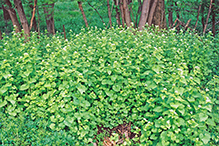 |
|||||
Plant |
|||||
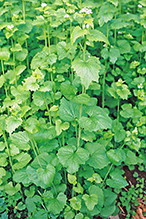 |
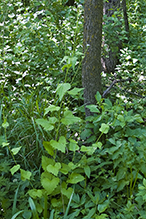 |
||||
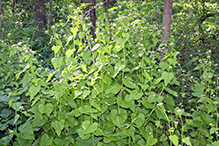 |
|||||
Inflorescence |
|||||
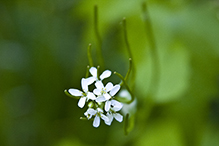 |
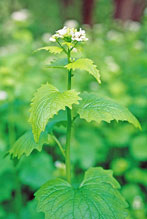 |
||||
Flowers |
|||||
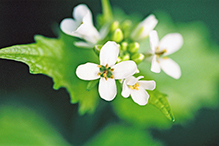 |
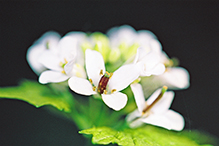 |
||||
Leaves |
|||||
 |
|||||
Leaf |
|||||
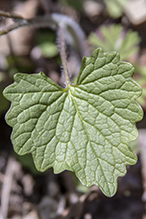 |
|||||
Infructescence |
|||||
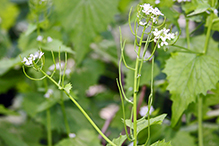 |
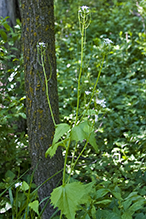 |
||||

Slideshows |
||
| Garlic Mustard Wez Smith |
||
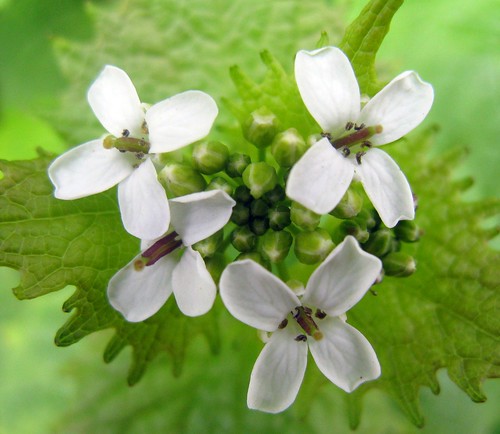
|
||
About
Garlic Mustard (Alliara petiolata). |
||
| Garlic Mustard - Alliaria petiolata Virens (Latin for greening) |
||
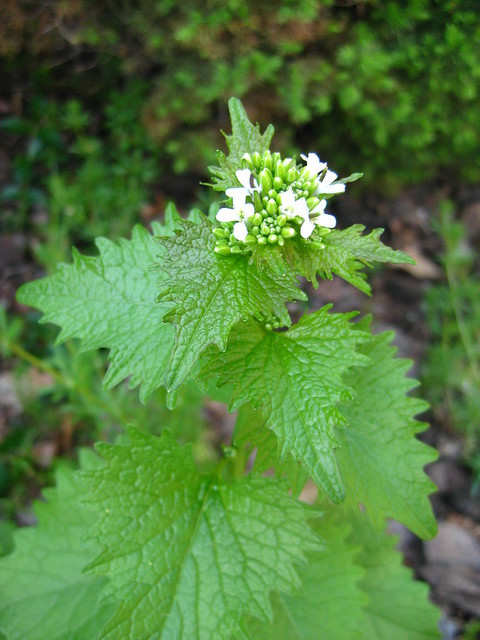
|
||
About
An invasive species which which poses an ecological threat to natural areas of New York State. A single plant can produce thousands of seeds, which scatter as much as several meters from the parent plant. Source: |
||
| Alliaria petiolata Susanne Wiik |
||
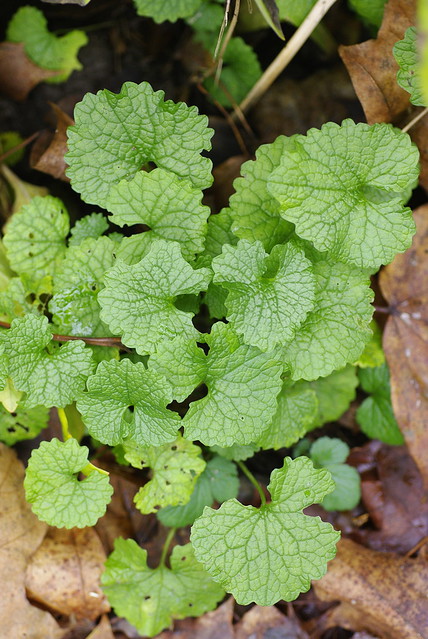
|
||
About
Løkurt, Garlic mustard, Jack-by-the-hedge |
||
| Alliaria petiolata GARLIC MUSTARD Frank Mayfield |
||
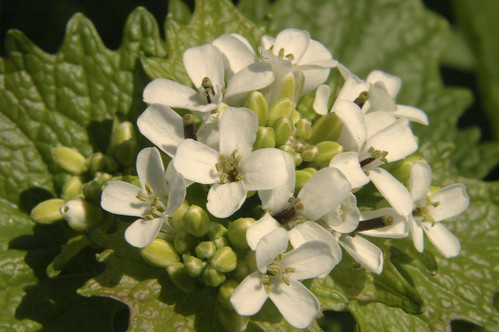
|
||

Visitor Videos |
|||
Share your video of this plant. |
|||
| This button not working for you? Simply email us at info@MinnesotaSeasons.com. Attach a video, a YouTube link, or a cloud storage link. |
|||
Other Videos |
|||
| Garlic Mustard, identification of the Wisconsin Invasive Species Alliaria petiolata uwcoopextension |
|||
About
Uploaded on Jan 31, 2011 This is part of a series of videos providing key characteristics for the identification of invasive plants listed in Wisconsin's invasive species administrative rule NR 40. These videos are produced by Dr. Mark Renz of the University of Wisconsin-Madison. For more information on invasive plants and invasive plant management in Wisconsin visit http://ipcm.wisc.edu/Publications/WeedSciencepublications/tabid/116/Default.aspx |
|||
| Garlic mustard (Alliaria petiolata) - 2012-04-29 W3stlander |
|||
About
Published on May 2, 2012 Garlic mustard (Alliaria petiolata) is a biennial flowering plant in the Mustard family, Brassicaceae. -------------------- |
|||
| The Invaders: Garlic Mustard UMDHGIC |
|||
About
Uploaded on Oct 24, 2009 Professional Horticulturist and Master Gardener Ellen Nibali identifies Garlic Mustard (Alliaria petiolata) and explains how to remove this invasive plant from your garden. Click here to read our publication on invasive species for even more information: http://www.hgic.umd.edu/_media/documents/publications/hg88.pdf This video is brought to you by the Home and Garden Information Center, part of University of Maryland Extension. Learn about our Grow It Eat It campaign, which provides resources and encourages people to start their own food gardens. http://www.growit.umd.edu/ Check out our facebook page for more gardening advice: http://www.facebook.com/UMDHGIC#!/GIEIMaryland Intro Credit: "Invasion of the Body Snatchers" (1956); Allied Artists. Music and shot of woman screaming used here in accordance with Fair Use. Shot and Edited by: Alix Watson and Emily Heimsoth |
|||
| Garlic mustard: A Minnesota woodland owner's story MyMinnesotaWoods |
|||
About
Uploaded on Jun 25, 2010 John Peterson shares his story of identifying, monitoring, and controlling invasive garlic mustard on his Minnesota woodland property. |
|||
| Your DNREC - Invasion of the Garlic Mustard Delaware DNREC |
|||
About
Published on May 11, 2012 Delaware's being invaded... you can help! |
|||

Visitor Sightings |
|||||
Report a sighting of this plant. |
|||||
| This button not working for you? Simply email us at info@MinnesotaSeasons.com. Be sure to include a location. |
|||||
|
|||||
MinnesotaSeasons.com Sightings |
|||||
Carver Highlands WMA, South Unit Clifton E. French Regional Park Forestville/Mystery Cave State Park Hardscrabble Woods / MG Tusler Sanctuary Mary Schmidt Crawford Woods SNA Minnesota Valley NWR, Black Dog Unit Minnesota Valley State Recreation Area, Lawrence Unit Nerstrand Big Woods State Park Prairie Creek WMA, Koester Prairie Unit Robert Ney Memorial Park Reserve |
|||||

|
Created: Last Updated: © MinnesotaSeasons.com. All rights reserved. |
